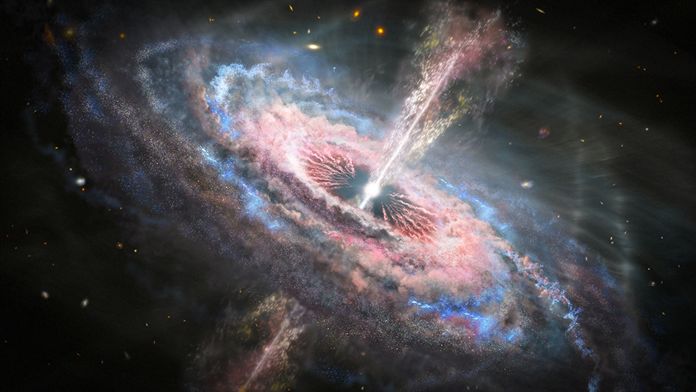
NASA, March 20, 2020 – Using the unique capabilities of NASA’s Hubble Space Telescope, a team of astronomers has discovered the most energetic outflows ever witnessed in the universe. They emanate from quasars and tear across interstellar space like tsunamis, wreaking havoc on the galaxies in which the quasars live.
Quasars are extremely remote celestial objects, emitting exceptionally large amounts of energy. Quasars contain supermassive black holes fueled by infalling matter that can shine 1,000 times brighter than their host galaxies of hundreds of billions of stars.
As the black hole devours matter, hot gas encircles it and emits intense radiation, creating the quasar. Winds, driven by blistering radiation pressure from the vicinity of the black hole, push material away from the galaxy’s center. These outflows accelerate to breathtaking velocities that are a few percent of the speed of light.
“No other phenomena carries more mechanical energy. Over the lifetime of 10 million years, these outflows produce a million times more energy than a gamma-ray burst,” explained principal investigator Nahum Arav of Virginia Tech in Blacksburg, Virginia. “The winds are pushing hundreds of solar masses of material each year. The amount of mechanical energy that these outflows carry is up to several hundreds of times higher than the luminosity of the entire Milky Way galaxy.”
The quasar winds snowplow across the galaxy’s disk. Material that otherwise would have formed new stars is violently swept from the galaxy, causing star birth to cease. Radiation pushes the gas and dust to far greater distances than scientists previously thought, creating a galaxy-wide event.
As this cosmic tsunami slams into interstellar material, the temperature at the shock front spikes to billions of degrees, where material glows largely in X-rays, but also widely across the light spectrum. Anyone witnessing this event would see a brilliant celestial display. “You’ll get lots of radiation first in X-rays and gamma rays, and afterwards it will percolate to visible and infrared light,” said Arav. “You’d get a huge light show—like Christmas trees all over the galaxy.”
Numerical simulations of galaxy evolution suggest that such outflows can explain some important cosmological puzzles, such as why astronomers observe so few large galaxies in the universe, and why there is a relationship between the mass of the galaxy and the mass of its central black hole. This study shows that such powerful quasar outflows should be prevalent in the early universe.
“Both theoreticians and observers have known for decades that there is some physical process that shuts off star formation in massive galaxies, but the nature of that process has been a mystery. Putting the observed outflows into our simulations solves these outstanding problems in galactic evolution,” explained eminent cosmologist Jeremiah P. Ostriker of Columbia University in New York and Princeton University in New Jersey.
Astronomers studied 13 quasar outflows, and they were able to clock the breakneck speed of gas being accelerated by the quasar wind by looking at spectral “fingerprints” of light from the glowing gas. The Hubble ultraviolet data show that these light absorption features created from material along the path of the light were shifted in the spectrum because of the fast motion of the gas across space. This is due to the Doppler effect, where the motion of an object compresses or stretches wavelengths of light depending on whether it is approaching or receding from us. Only Hubble has the specific range of ultraviolet sensitivity that allows for astronomers to obtain the necessary observations leading to this discovery.
Aside from measuring the most energetic quasars ever observed, the team also discovered another outflow accelerating faster than any other. It increased from nearly 43 million miles per hour to roughly 46 million miles per hour in a three-year period. The scientists believe its acceleration will continue to increase over time.
“Hubble’s ultraviolet observations allow us to follow the whole range of energy output from quasars, from cooler gas to the extremely hot, highly ionized gas in the more massive winds,” added team member Gerard Kriss of the Space Telescope Science Institute in Baltimore, Maryland. “These were previously only visible with much more difficult X-ray observations. Such powerful outflows may yield new insights into the link between the growth of a central supermassive black hole and the development of its entire host galaxy.”
The team also includes graduate student Xinfeng Xu and postdoctoral researcher Timothy Miller, both of Virginia Tech, as well as Rachel Plesha of the Space Telescope Science Institute. The findings were published in a series of six papers in March 2020, as a focus issue of The Astrophysical Journal Supplements.
The Hubble Space Telescope is a project of international cooperation between NASA and ESA (European Space Agency). NASA’s Goddard Space Flight Center in Greenbelt, Maryland, manages the telescope. The Space Telescope Science Institute (STScI) conducts Hubble science operations. STScI is operated for NASA by the Association of Universities for Research in Astronomy, in Washington, D.C.
 |
 |
 |





